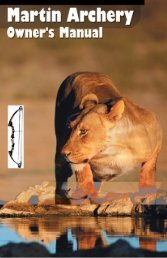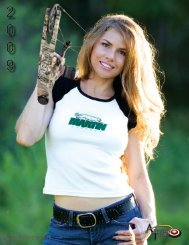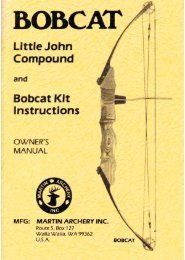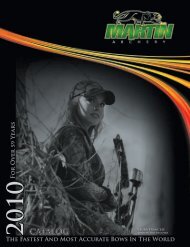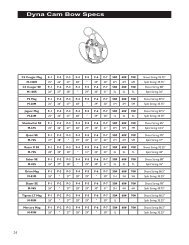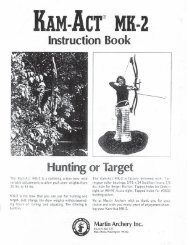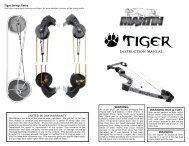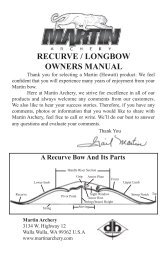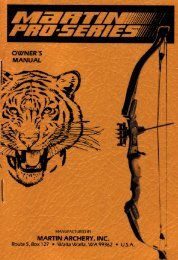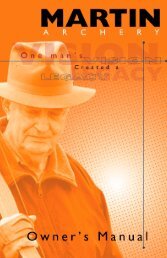FiNE TUNiNG YOUR COMPOUNd BOw - Martin Archery
FiNE TUNiNG YOUR COMPOUNd BOw - Martin Archery
FiNE TUNiNG YOUR COMPOUNd BOw - Martin Archery
- No tags were found...
You also want an ePaper? Increase the reach of your titles
YUMPU automatically turns print PDFs into web optimized ePapers that Google loves.
Owner's RecordBow Model:______________________________Date Purchased:______________________________Cam Style:______________________________Draw Weight:______________________________Draw Length:______________________________String Length:______________________________Cable Length:______________________________Purchased From:______________________________NOTICE:Staple your sales receipt hereProof of purchase date is neededshould you ever require warranty workWelcome to the <strong>Martin</strong> <strong>Archery</strong> Family. We are confident that you will experience manyyears of enjoyment from your new <strong>Martin</strong> bow. Each bow that leaves our door is handmadeone at a time as they have been for over 57 years. <strong>Martin</strong> <strong>Archery</strong> remains a family ownedand operated business. We take great pride in every product we produce and we strive tooffer you the most complete line of professional accessories available.We welcome any comments you may have about our products. We also like to hearstories of your successes while using our products. If you have any comments, photos, orinformation you would like to share with us, please call or write. We will do our best to answerany questions you may have.To better serve you, we have the most complete archery manufacturer's web page on theWorld Wide Web. Our web page is located at: www.martinarchery.comThank You,2Gail <strong>Martin</strong>Founder and President
Table Of ContentsParts Of The Bow.....................................................................4Basic Setup• Cable Guard And Arrow Alignment .......................................................5• Setting Arrow Rest Position ...................................................................5• Quick Arrow Rest And Nock Placement ................................................6• Setting Tiller............................................................................................6• Measuring Draw Length ........................................................................6• Setting Nock Point With A Bow Square .................................................7• Changing Draw Weight ..........................................................................7• Replacing The Strings ...........................................................................7• Care and Storage ..................................................................................7• Installing and Adjusting The Draw Stop .................................................8Cam Systems•M-Pro and Mini M-Pro• Parts of the Single System ....................................................................9• Adjusting The Single Draw Length ........................................................9• Single String Diagram ............................................................................9•C.A.T. Duo Cams• Parts of the C.A.T. Cam System ............................................................10• Changing the C.A.T. Cam Draw Length ................................................10• C.A.T. Cams String Diagram .................................................................10• Tuning the C.A.T. Cams ........................................................................12•Furious & Furious-X Cams• Parts of the Furious System ..................................................................11• Changing the Furious Draw Length .......................................................11• Converting to The X Shoot-Through System .........................................11• Tuning the Furious Cams ......................................................................12Fine Tuning Your Compound Bow• Bare Shaft Planing Test ......................................................................... 13-14• Paper Tuning ......................................................................................... 15-17<strong>Archery</strong> Safety ............................................................................ 17Superfine Tuning• Paper Tuning ......................................................................................... 18• Flight Tuning Broadheads ..................................................................... 19Warranty ............................................................................................ 203
Parts Of The BowIdler WheelAxleUpper LimbLimb BoltVibrationEscapeModuleCablesBarrel NutQuiver MountsShooting StringRiserCable GuardLock MountGripStabilizerInsertLimb PocketLower LimbCam4Model Shown: Bengal with M-Pro CamInformation in this manual pertains to all <strong>Martin</strong> Bow Models.
Basic SetupYour new <strong>Martin</strong> bow takes little setup to get started shooting. Please read andfamiliarize yourself with these starting procedures before shooting. Many of theseprocedures may have been completed by your authorized <strong>Martin</strong> dealer. Aftercompleting these simple steps, you will be more accurate and will have greater successfrom the start. A careful and thorough initial setup will make the tuning process much easier.Cable GuardThe Cable guard should be positioned for adequatefletching clearance. Depending on model, your bow may havea strait carbon cable guard installed. If so, your cable guard isalready positioned for optimum fletching clearance, and no furtheradjustment is needed. If your bow came with a metal, dog leggedcable guard, please follow the directions below. Caution should betaken against over rotating the cable rod as excessive clearancecan cause unnecessary pressures on the limb and axle bearings.The cable guard rod should be rotated to provide adequate fletchingclearance. Caution should be taken against over rotating the rod asexcessive clearance can cause unnecessary pressures on the limbtips and axle bearings.Follow these steps:1. Visually align shooting string down the center of the grip.2. Adjust arrow rest left or right so arrow is centered with theshooting string.3. Adjust cable guard so that cables are off-set no more than neededfor fletching clearance.2 3Once optimum angle is achieved, fully tighten the screw, but do not over tighten.1Setting Arrow Rest PositionAfter your arrow rest is installed, you willneed to set it at a good starting point tobegin tuning. The easiest way to do this is tovisually align the bowstring in the center ofthe grip section. If you are shooting your bowwith a release aid, your rest will need to becentered with the bow string. During tuning, yourarrow rest may need to be moved in or outfrom its centered location. This is normalbecause different shooters apply differentpressures to the bow. Finger shooters willneed to position the rest so that the pointis about 1/8” outside the string. This is tocompensate for the horizontal bending ofthe arrow upon release. An arrow rest thatprovides some side support, such as acushion button for the arrow, is best for fingershooters.FingerSettingReleaseSetting5
Basic SetupInstalling and Adjusting the Draw Stop.There are a total of four parts to the Draw Stop assembly. A rubber cap, thealuminum body of the Draw Stop, an 8/32 screw and an 8/32 hex nut. To install the stop,place the hex nut in the track on the back side of the cam. Next, insert the 8/32 screw into thealuminum body of the Draw Stop and thread the screw into the hex nut from thenumbered side of the cam. To adjust the stop, draw thebow back either by hand or in a scale/shooting machine. Atfull draw, slide the stop until it contacts the face of the limb.Back the stop off of the limb 1/32” (appox.) to allow for therubber cap to be installed. Snug down the Draw Stop with theappropriate Hex head wrench, and install the rubber cap overthe Draw Stop. You should also have 2 (two) thin felt pads aswell. One will be placed on the limb where the draw stop makescontact, and the other should be wrapped around the DrawStop as well.8
M-Pro & Mini M-Pro Cams<strong>Martin</strong> Single Cam systems feature a modular draw length adjustment. A series of drawlength modules are used to adjust draw length in one-inch increments (see below). Drawlengths can also be adjusted in half-inch increments within each size module.Parts Of The Single Cam SystemsModuleScrewsModuleDrawStopNumbered PegsSpeed BearingSpeed BearingBottom CamIdler WheelAdjusting The Single Cam Draw LengthUsing draw length modules, the draw length can be adjusted in 1" increments. Themodules can also be used to adjust the let-off. A high let-off module is marked as "F". A 65%let off module is marked with a "F/". The slash on the end of the size number indicates 65%let-off. To change the draw length, replace the module on the cam by removing the screwsthat hold it to the cam. NOTE: do not draw your bow without the module installed. Itwill damage your harness.The module sizes range from F-1 to F-7. As the module numbers get higher, the drawgets longer. The draw length can also be adjusted in 1/2" increments using the pegs on theback of the cam.If your cam has numbered pegs, moving your cable to a higher number peg will decreaseyour draw length by 1/2". Move to a lower numbered peg to increase your draw length by1/2".Single Cam String DiagramThe string harness on your Single Cam is installed according to the diagram below. Yourstring harness should be installed by your qualified <strong>Martin</strong> dealer.2nd halfShootingStringSplitStringShootingStringShooting String comesstraight off of curve9
C.A.T. Duo CamsYour C.A.T. Cams are each equipped with a rotating draw length module. Each drawlength module has numbers that indicate draw length settings. The Standard Modulehas positions that number #1 through #7, with each number providing ½” additional drawlength. The Long Module has positions #8 and #9. The higher the # position, the longer thedraw length.Parts of the C.A.T. Duo CamModule ScrewsModuleSpeed BearingDrawStopModuleC.A.T. Bottom CamShootingString AnchorModule ScrewsC.A.T. Top CamChanging the C.A.T. Draw LengthWhen you are adjusting the draw length, make surethat both the upper and lower modules are in the samesetting. To rotate the modules, you will first need toremove the two (2) allen head module screws. Rotatethe module to the desired position and replace andtighten the screws in the appropriate positions.DO NOT attempt to draw the bow without thedraw length modules in place and secured.C.A.T. Cam String Diagram10
Furious & Furious-X CamsYour Furious and Furious-X Cam System utilizes a series of three (3) different rotatingdraw length modules, sizes (small), M (medium), and L (large). Draw Length positions arenumbered 1 (shortest) thru 4 (longest), and are positioned to provide draw length adjustmentsin 1/2 “ increments. See your local dealer or visit www.martinarchery.com for details on yourcorrect module size and position.Parts of the Furious and Furious-X CamsModule ScrewsCable Anchor Module SideBase CamX-Module Cable AnchorCable GuideExtended ModuleScrewsBushingModuleShootingString AnchorX-ModuleFuriousFurious-XChanging The Furious Draw LengthYour Furious Cam may be an X Shoot-Throughsystem or a standard system, but the draw isadjusted basically the same. The threaded modulehas numbers and dashes on it that indicate whatsetting you are on while you are adjusting it. Thedashes signal 1/2" draw increments. When you areadjusting the draw, make sure that both modulesare in the same setting. To rotate the modules, youwill need to remove the mod screw closest to theCable Guide and loosen the module screw that isclosest to the axel. Slide the module to the desiredposition and replace and tighten the screws in theappropriate positions. The modules provide alonger draw as the module number gets higher.BushingBossCable AnchorCable GuideModSettingsConverting To The X-Shoot Through SystemThe Furious-X system eliminates the cable guard and the pressures it creates.Converting your Furious System to the X Shoot-Through System is very easy. All you needto do is order a conversion kit from your dealer and it will come with X-Modules, cables, longmod screws, and long axles. Your dealer can easily add the second module to the top andbottom and then slide in the long axles with the use of a bow press. Install the four cablesand presto! You have a Furious-X system.11
Fine Tuning Your Compound BowAfter completing the basic setup procedures, you are ready to fine tune your setup for thebest accuracy possible. There are four tuning methods described in this section. Some ofthese methods may not apply to certain styles of shooting. Read the introduction to eachmethod carefully to make sure it applies to your shooting style.•Bare Shaft Planing TestThe Bare Shaft Planing method of tuning works best when using a finger release. To beginthe Bare Shaft Planing test you will need three fletched arrows and one or two bare shafts.You will also need a target that will catch the arrows without allowing the arrow to kick as itstops in the target. This test will help you establish the correct nock and rest position, andit will tell you if your arrow is the correct spine. Porpoising and Fish Tailing describe thedifferent flight disturbances you may encounter while tuning.•PorpoisingPorpoising is identified by an up and down kick during arrow flight and relates to thenock point adjustment. It is important to correct porpoising first because small left and rightdisturbances could be nock point related. Start at about ten to fifteen yards and shoot threefletched arrows into your target. Using the same aiming point, follow them up with a bareshaft. After you get the bare shafts to impact with the fletched shafts, you may want to tryshooting them at a longer distance for a finer indication of arrow flight.A high nock set will cause porpoising.If the bare shafts impact below the fletched arrows, your nock point is too high. Moveyour nocking point down in small increments until the bare shaft strikes with the fletchedshafts. If the bare shafts impact above your fletched arrows, your nock point is too low. Raiseyour nock point in small increments until your fletched arrows and your bare shaft impacttogether.Repeat the above steps from a longer distance to make sure you havecompletely corrected the nock point. Shooting from a longer distance will make minordisturbances more apparent.High nocking pointLow nocking point.13
Fine Tuning Your Compound Bow•FishtailingFishtailing relates to the arrow rest adjustment and the stiffness of yourarrow. Just as before, start at about ten to fifteen yards and shoot three fletched arrows intoyour target. Using the same aiming point, follow them up with a bare shaft. After you getthe shafts to impact with the fletched shafts, you may want to try shooting them at a longerdistance for a finer indication of arrow flight.If your unfletched shafts impact to the left of your fletched shafts, your arrow is too stiff.There are two things that you can do to correct this problem; you can select a weakerarrow, or you can decrease the cushion plunger tension. Increasing the peak weight ofyour bow or increasing your point weight will also make your arrow act a bit more limber.If your unfletched shafts impact to the right of your fletched shafts, your arrow is too limber.There are two methods you can try that will correct this problem; you can select a stifferarrow, or you can increase the cushion plunger tension. Decreasing the peak weight of yourbow or decreasing your point weight will also make your arrow act a bit more stiff.To further fine tune your setup, step back to twenty or thirty yards and repeatthe above procedures. Small flight disturbances will show up better as you getfarther from the target. Your <strong>Martin</strong> bow is essentially tuned when your bare shafts hittogether with your fletched shafts. Keep in mind that if you continue and complete the superfine tuning methods in this manual, it is not uncommon for your bare shaft impact to change.Even with your bow shooting its best, it is common for a perfectly tuned bow to shoot a bareshaft a bit low and right or low and left. Perfect arrow groups are the goal when completingthese exercises.Stiff Arrow.Bare shafts fly to left.Limber ArrowBare shafts fly to right.Left handed shooters should follow instructions in reverse.14
Fine Tuning Your Compound Bow•Paper TuningPaper tuning will work for all styles of shooting. As you are going through these stepskeep in mind that paper tuning is not chiseled in stone as the law of archery. It is aguideline for clean arrow flight. Many shooters find that their setup shoots most accuratelywhen achieving less than perfect tuning results. For example, some target shooters set theirbows to tear slightly high through the paper. They feel this makes their arrow flight less likelyto be influenced by outside variables like wind or rain and helps arrow clearance when usinga shoot-around type rest such as a blade or pan type launcher.To begin paper tuning, set up a frame or rack with paper suspended from theframe. Position the frame far enough away from your backstop so the arrow cancompletely clear the paper. Stand about ten feet from the paper and make sureyour arrow is level as it flies through the paper. Fire a test shot and read the results.Compare the holes you have made in the paper to the diagrams below.Procedures for correcting the tear are listed next to each diagram. Please note that tuningprocedures recommended for finger shooting often differ from those used forrelease shooting. You will find that the arrow spine reaction is different for fingersand release, therefore, the procedures for correcting the different disturbances vary.Follow the instructions carefully for your particular shooting style.Hight Tear (fletching tears above point)This tear may signal:•Nocking point too high: Lower the nocking point.•Improper vane clearance: See if arrow fletching is hitting the rest.•Launcher is too stiff (release shooters): Weaken spring tension oruse a more limber launcher.•Wheels may be out of time: Check wheel timing.•Arrow may be too limber: Select a stiffer arrow shaft.•Tiller adjustment may be incorrect: See basic setup section page 6.•Irregular or inconsistent shooting form: See a qualified archery coachor professional and have them check your technique.Low Tear (fletching tears below point)This tear may signal:•Nocking point too low: Raise the nocking point.•Wheels may be out of time: Check wheel timing.•Tiller adjustment may be incorrect: See basic setup section on page 6.•Irregular or inconsistent shooting form: See a qualified archerycoach or professional and have them check your technique.15
Fine Tuning Your Compound Bow•Paper Tuning -ContinuedRight Tear (fletching tears to the right of point)This tear may signal:Note: If you are left handed follow these instructions in reverse.Fingers:•Stiff arrow.This problem is cured using one or more of the following methods:a. Increase peak weight.b. Use a heavier point.c. Select a more limber arrow.d. Lighten cushion plunger tension, or use a weaker spring on shoot around rests.e. Make small incremental rest adjustments towards the bow.Release:•Arrow rest is too far to the right: Move arrow rest to the left.Either Style:•Too much pressure on the cable guard: Rotate cable guard for minimumfletching clearance.•Irregular or inconsistent shooting form: See a qualified archery coach orprofessional and have them check your technique.•Clearance problem: See that arrow has adequate fletching clearance.Left Tear (fletching tears left of point)This tear may signal:Note: If you are left handed follow these instructions in reverse.Fingers:•Weak arrow or a clearance problem.This problem is cured using these methods:a. Reduce bow weight.b. Use a lighter point.c. Select a stiffer arrow.d. Increase cushion plunger tension or use a stiffer spring on shoot around rests.e. Make small incremental rest adjustments away from the bow .Release:•Arrow rest is too far to the left: Move the arrow rest to the right.•Arrow is too weak: Decrease bow weight or select a stiffer arrow.Either Style:•Arrow is not properly clearing cables: Rotate cable guard for completefletching clearance.•Irregular or inconsistent shooting form: See a qualified archery coachor professional and have them check your technique.•Arrow rest clearance problem: See that arrow has adequate fletchingclearance through or over the arrow rest.16
Superfine Tuning•Paper TuningShort range group tuning will work with any style of shooting. Best results are achievedwhen this method is used after completing the Bare Shaft Planing or Paper Tuning tests.This is a good ultra fine tuning method when space will not permit long range shooting. Aftercompleting the following steps you will have very clean arrow flight and a well tuned, accuratesetup.To begin the short range tuning method, you will need a piece of cardboard, or a targetface. Make a broad line through the center of the paper on the blank side, making sure theline is thick enough to see from twenty yards. Start at about 10 to 15 yards from the target.Use your tuning target and position the line vertically when you are tuning the arrow rest andposition the line horizontally when you are tuning the nock point.Vertical ImpactPosition your line horizontally and shoot six arrows at the line.Concentrate on keeping your pin on the line. Don’t worry aboutleft and right hits, just try to keep your shots on the line. Shoot twogood groups, discarding any rough or bad shots, and note thevertical impact of the arrows and their relationship to the line. Alladjustments are made with the nock point during these steps.If your arrows are not consistently grouping on the line, makesmall 1/32" adjustments up or down with the nock point and shoottwo more groups. Continue making nock adjustments in smallincrements. If all of your arrows begin to hit on the line you arecorrecting the nock position. In the event that your groups widen,move your nock back to its original location and make small adjustmentsin the opposite direction.This pattern shows avertical disturbance.This pattern shows aclean vertical pattern.Horizontal ImpactAfter achieving a nice, straight, horizontal pattern, rotate your targetso your line will appear vertical. Just as before, shoot two good groups,discarding any rough or bad shots, and note the horizontal impactof the arrows and their relationship to the line. All adjustments aremade with the arrow rest during these steps.If your arrows are not consistently grouping on the line, makesmall 1/32" adjustments left or right with the arrow rest andshoot two more groups. Continue making rest adjustments insmall increments. If all of your arrows begin to hit on the line youare correcting the rest position. In the event that your groupswiden move your rest back to its original location and make smalladjustments in the opposite direction.This patternshows ahorizontaldisturbance.This patternshows a cleanhorizontalpattern.18
Superfine Tuning•Flight Tuning BroadheadsBroadhead tuning will work for all styles of shooting. After you have completed one ormore of the tuning procedures described in this manual, you can proceed with this final testto get your new bow ready to hunt. You will need three fletched arrows with field tips andthree with broadheads that weigh the same as your field tips.Before you begin shooting, you will need to check your broadhead equippedarrows. After installing your broadheads, make sure they are perfectly straight on the shaft.This can be done by spinning the arrow on a flat counter while checking for any broadheadwobble. You can also use a commercially made spin check tool that is available from yourdealer. After all of your broadheads are spin-checked and straight you are ready to begin.Set up a broadhead target at twenty or thirty yards and shoot three arrows with field tips.Make sure you are properly warmed up and you are shooting to the best of your ability.Next, shoot three identically aimed arrows with broadheads. WARNING: NEVER SHOOTBARE SHAFTS WITH BROADHEADS ATTACHED. THE FLIGHT WILL BE EXTREMELYUNPREDICTABLE AND DANGEROUS. Once you have shot the best group you can shoot,compare the position of the broadhead group to the field tip group. Compare the groupsto the diagram below and make very small incremental adjustments as described next tothe broadhead group that corresponds to your arrow pattern. Note: make very small 1/32"adjustments. A small adjustment will greatly change your broadhead flight.•Multidirectional FlightCorrect the nock point first.Once the arrow is straight left,follow instructions for left flight.•High FlightRaise nock pointField Point GroupBroadhead Group•Left FlightRelease:Move arrow rest tothe right in smallincrements.•Right FlightRelease:Move arrow restto the left insmall increments.Fingers:•Slightly increasedraw weight.•Use a heavierbroadhead.•Decrease cushionplunger tension.•Move plunger toward thebow in small increments.Reverse steps for left hand shooter.•Low FlightLower nock pointFingers:• decreasedraw weight.•Use a lighterbroadhead.•Increase cushionplunger tension.•Move plunger awayfrom the bow in small increments.Reverse steps for left hand shooter.19
Warranty*Lifetime Bumper To Bumper WarrantyLIFETIME WARRANTYAll <strong>Martin</strong> Compound Bows are warranted against defects in materials or workmanship to theoriginal owner, on all risers, limbs, limb pockets, axles, bearings, and cams (everything exceptthe string and cables) for 10 years (starting at the date of purchase) and then 50% list price for thelife of the product*. (Strings and cables are not included, and should be changed either everyseason, or anytime they show wear, whichever comes first.)(*The life of a bow is determined according to the production cycle of the model andon-hand supply of replacement components. Should a bow no longer be in production and supply ofcomponents be exhausted, an upgrade fee may be charged in order to supply the customer witha newer, updated model.)The warranty is conditioned upon proof of purchase and other requirements listed below. ITIS IMPORTANT THAT <strong>YOUR</strong> SALES RECEIPT BE FILED IN A SAFE PLACE FOR FUTUREREFERENCE, AS REPAIRS WILL NOT BE PERFORMED UNDER WARRANTY WITHOUT A COPYOF THE DATED SALES RECEIPT. <strong>Martin</strong> <strong>Archery</strong>, Inc. warrants that your <strong>Martin</strong> compound bow willperform its intended function if used in accordance with the instructions provided. This Lifetime Warrantycovers only the replacement parts, labor, and return ground transportation costs performed by <strong>Martin</strong><strong>Archery</strong> Inc. to the customer. Transportation for the return of the bow to <strong>Martin</strong> <strong>Archery</strong>, Inc. is notcovered. No C.O.D. shipments will be accepted by <strong>Martin</strong> <strong>Archery</strong>, Inc. Warranty repairs can beperformed by an Authorized <strong>Martin</strong> Dealer, for which <strong>Martin</strong> <strong>Archery</strong>, Inc. will cover replacement partsand ground transportation costs to the Authorized Dealer. Labor costs for warranty repairs performedby Authorized Dealers are not covered by <strong>Martin</strong> <strong>Archery</strong>, Inc. <strong>Martin</strong> <strong>Archery</strong> makes no other warrantyeither expressed or implied, whether of fitness or of marketability, except as stated above. Any suchadditional warranty is expressly disclaimed. No agent, employee, or representative of <strong>Martin</strong> <strong>Archery</strong> orits dealers has the authority to bind <strong>Martin</strong> <strong>Archery</strong> to any agreement not herein stated. Buyer agreesthat the sole and exclusive remedies for breach on any warranty concerning <strong>Martin</strong> <strong>Archery</strong> Bows shallbe repair or replacement of defective parts. <strong>Martin</strong> <strong>Archery</strong> shall not be liable for injury or property otherthan the bow itself. <strong>Martin</strong> <strong>Archery</strong> reserves the right to replace defective parts according to availabilitywith compatible replacement parts.Warranty limitations are as follows:1. If bow shows signs of misuse, alteration, or mishandling this warranty will be void. Use of arrowsweighing less than five (5) grains per pound of draw weight is considered misuse and will voidthis warranty.2. Claimant must be the original purchaser. This warranty is not transferable.3. All returns to <strong>Martin</strong> <strong>Archery</strong> Inc. must be pre authorized. Owner must contact <strong>Martin</strong> <strong>Archery</strong>, Inc.at (509) 529-2554 prior to shipping in order to obtain a Return Authorization number.4. All accessory items must be removed from the bow prior to shipping. <strong>Martin</strong> <strong>Archery</strong>, Inc. will notbe responsible for damage or loss of any accessory item left on the bow.5. Warranty is not effective unless a copy of the dated sales receipt accompanies the bow.6. This warranty gives you specific legal rights. You may also have other rights which vary from stateto state.* This policy is subject to change and/or cancellation at the discretion of <strong>Martin</strong> <strong>Archery</strong>, Inc.* After acquiring a Return Authorization number, send bow to:<strong>Martin</strong> <strong>Archery</strong>, Inc.3134 W. Highway 12Walla Walla, WA 9936220



